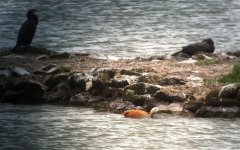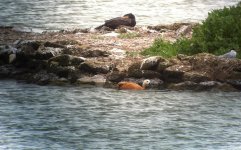Jonny Rankin
Formerly Jonny Crossbill
Hi all,
Found a female Ruddy Shelduck at Snettisham RSPB Saturday lunchtime (see attached), I reported it to the news services although it doesn't appear to have been reported since.
Got me thinking about Ruddy Shelducks and their tickability; looking through Birdguides, since the start of June there have been up to 23 individuals across over ten counties. With five reported in the humber estuary on the 20th of this month alone.
Reading this Keith Vinicombe article it seems these late summer records refer to overshooting Dutch birds and there arrival is annual...
I note there was a little debate on a Birdforum thread back in 09 but wondered if peoples views given subsequent records / years may have changed... coincidentally I understand a pair successfully breed in Sennowe Park, Norfolk the same year.
Basically given the annual records peaking in later summer, put simply, I don't understand why I cannot tick 'em?
I've also added a poll on my blog (see right had side) so feel free to vote on whether you'd tick Ruddy Shelduck or not there...
I look forward to hearing from people.
Cheers,
Jonny
Found a female Ruddy Shelduck at Snettisham RSPB Saturday lunchtime (see attached), I reported it to the news services although it doesn't appear to have been reported since.
Got me thinking about Ruddy Shelducks and their tickability; looking through Birdguides, since the start of June there have been up to 23 individuals across over ten counties. With five reported in the humber estuary on the 20th of this month alone.
Reading this Keith Vinicombe article it seems these late summer records refer to overshooting Dutch birds and there arrival is annual...
I note there was a little debate on a Birdforum thread back in 09 but wondered if peoples views given subsequent records / years may have changed... coincidentally I understand a pair successfully breed in Sennowe Park, Norfolk the same year.
Basically given the annual records peaking in later summer, put simply, I don't understand why I cannot tick 'em?
I've also added a poll on my blog (see right had side) so feel free to vote on whether you'd tick Ruddy Shelduck or not there...
I look forward to hearing from people.
Cheers,
Jonny







